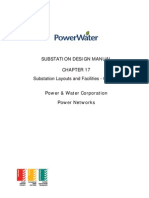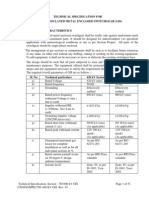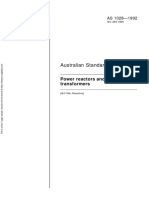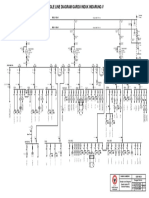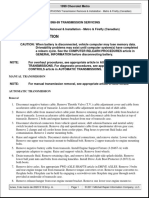Rolling Sphere Tool Guide: I. II. Iii
Uploaded by
Rashad SarwarRolling Sphere Tool Guide: I. II. Iii
Uploaded by
Rashad SarwarRolling Sphere Tool Guide
I. II. III. Calculate Protection Calculate Failure Rate References
I.
Calculate Protection
Test the coverage provided by the lightning shielding system. The tool will provide the geometric zones of protection. It may be appropriate to trace these protection zones on plan and section views of the substation to accurately identify protected and unprotected areas. In this section the following topics are explained. (Use the links below to navigate to a specific topic.) Shielding Configuration BIL h(e) r(c) h(m) h(w) d(max) d(1), d(2), d(3) I(s) Z(s) S r x(1), x(2), x(3) r(1) sin R (triple mast) R (triple wire) b r(2)
Shielding Configuration
Select from one of the standard shielding configurations to test its coverage. Each one requires different input parameters. Depending on their locations, multiple masts and wires can provide added coverage beyond their individual contributions. This calculator can help determine this added coverage when selecting the appropriate configuration. If the desired configuration is not listed, divide the testing area into configurations that are listed. Alternatively, use the single mast and wire configurations to determine strike distances for each individual shielding electrode and determine the protected areas graphically.
Created by Biren Patel
Page 1 of 14
v1.2
Rolling Sphere Tool Guide, Continued
BIL
Basic Impulse Level, also known as Basic Insulation Level, refers to the rating of the equipment insulation in kV. It can be used to define the maximum voltage produced by stroke current an insulator can withstand without flashover. Separate calculations are required for each BIL used in a station. From 5.3.6 of IEEE 998-1996, use a minimum stroke current of 2 kA for stations operating below a voltage of 115 kV. This is a practical recommendation because 99.8% of all lightning strokes exceed 2 kA. Since stations below 115 kV typically have a BIL of 350 kV or less, choosing this option fixes I(s) at 2 kA.
h(e)
Height of equipment refers to the equipment or bus needing protection (in feet). As h(e) increases, the maximum distance from the shielding device (r) must shrink to keep the equipment under the rolling sphere. Surge impedance (Z(s)) of a conductor is also affected by h(e). A conductor farther from the ground has greater surge impedance than a conductor closer to the ground.
Created by Biren Patel
Page 2 of 14
v1.2
Rolling Sphere Tool Guide, Continued
r(c)
Radius of conductor refers to the radius or effective radius (in feet) of the energized bus needing protection. It is used to calculate the surge impedance. Separate calculations are required for each type of conductor. The linked reference guide identifies typical values (in inches) for many conductors as a diameter. Remember to divide by 12 to get a radius in feet. If there are bundled conductor strands, then input their effective radius (R(0)) given by the following equations from Annex C of IEEE 998-1996: Two-conductor bundle:
R(0) = r l Three-conductor bundle: R (0) = 3 r l 2 Four-conductor bundle:
R(0) = 4 2 r l3
n-conductor bundle:
R (0 ) = 0.5 l 'n n 2 r l'
where r l l n is the radius of the subconductor (in feet) is the spacing between adjacent conductors (in feet) is the diameter of the circle on which the subconductors lie (in feet) is the number of subconductors
h(m)
Height of mast refers to the height of the shielding mast above ground (in feet). A mast height greater than or equal to the strike distance provides the most protection. For masts, the value of the coefficient k from Eq 5-1B of IEEE 998-1996 is 1.2. When calculations require multiple masts, the shortest mast should be used for h(m).
Created by Biren Patel
Page 3 of 14
v1.2
Rolling Sphere Tool Guide, Continued
h(w)
Height of wire refers to the height of the shield wire above ground (in feet). A shield wire height greater than or equal to the strike distance provides the most protection. Select the height at mid-span to ensure a conservative approach. For shield wires, the value of the coefficient k from Eq 5-1B of IEEE 998-1996 is 1. When calculations require multiple wires, the lowest wire should be used for h(w).
d(max)
Maximum distance refers to the greatest horizontal distance (in feet) two masts or two wires can be placed from each other and still provide protection for equipment between them, provided that the equipment does not exceed a height of h(e). If d(1), d(2), or d(3) exceeds d(max), then the bottom of the sphere penetrates below the equipment height, even if it rests atop the shielding electrodes. To find d(max) between a wire and mast, conservatively select the Double Wire configuration. d(max) is calculated according to the following equation from Exhibit B.5-5 of IEEE 998-1996: For a mast:
d (max) = 2 S 2 (S h(m) + h(e) )
2
For a wire:
d (max) = 2 S 2 (S h( w) + h(e) )
2
where d S h(m) h(w) h(e) is the distance between two adjacent structures (in feet) is the strike distance (in feet) is the height of the shield mast (in feet) is the height of the shield wire (in feet) is the height of the equipment or bus to be protected (in feet)
d(1), d(2), d(3)
These variables refer to the distances between adjacent masts or shield wire lengths (in feet), as described by the diagrams. If they exceed d(max), consider reducing the distance between shielding electrodes. If the electrodes are already in service or cannot be relocated closer, analyze protection using a simpler shielding configuration such as single mast or single wire. Perform failure rate calculations for exposed areas.
Created by Biren Patel
Page 4 of 14
v1.2
Rolling Sphere Tool Guide, Continued
I(s)
Stroke current refers to the maximum allowable current the station bus and insulation can withstand before experiencing flashover in kA. It is calculated according to Eq 5-2A and section 5.3.6 of IEEE 998-1996: Stroke current:
I (s) = 2.2 BIL Zs for BIL > 350 kV
I ( s ) = 2kA where
for BIL 350 kV
BIL is the Basic Impulse Level rating of the insulation in kV Z(s) is the surge impedance of the conductor in
Z(s)
Surge impedance refers to the impedance of the conductor that the lightning surge is passing through in . There is no input for this in the tool because it is approximated from the EPRI Red Book by Eq 12.5.5. Surge impedance: Z ( s ) = 60 ln(2h(e) / r (c)) where h(e) is the height of the equipment or bus above ground (in feet) r(c) is the radius or effective radius of the conductor (in feet)
Created by Biren Patel
Page 5 of 14
v1.2
Rolling Sphere Tool Guide, Continued
S
Strike distance refers to the length of the last stepped leader (in feet), and therefore defines the radius of the rolling sphere which rolls over the ground and shielding electrodes. Any equipment that exists in the path of this rolling sphere is considered unprotected. It is calculated according to Eq 5-1B of IEEE 998-1996: Strike distance: S = 26.25kI ( s ) 0.65 where k Is is a coefficient to account for different striking distances for masts and wires. It is 1.2 for strikes to masts and 1 for strikes to wires is the stroke current in kA
r
Radius of protection refers to the distance (in feet) from the shielding electrode to the edge of protection for a given equipment height. It is calculated according to the following equations from Camden: For a mast:
r = S 2 ( S h(m)) 2 S 2 ( S h(e)) 2 r = S S 2 ( S h(e))2 For a wire: r = S 2 ( S h( w)) 2 S 2 ( S h(e)) 2 where S h(m) h(w) h(e)
for h(m) < S for h(m) S
is the strike distance (in feet) is the height of the shield mast (in feet) is the height of the shield wire (in feet) is the height of the equipment or bus to be protected (in feet)
Created by Biren Patel
Page 6 of 14
v1.2
Rolling Sphere Tool Guide, Continued
x(1), x(2), x(3)
These variables refer to the distance (in feet) from the midpoint of adjacent masts (or shield wire supports), perpendicular to the center of the unprotected area with radius r1 as described in the diagrams. They are calculated according to the following equations from Camden: For a mast: x = S 2 (d ) 2 ( S h(m)) 2 2 For a wire: x = S 2 (d ) 2 ( S h( w)) 2 2 where d S h(m) h(w) is the distance between two adjacent structures (in feet) is the strike distance (in feet) is the height of the shield mast (in feet) is the height of the shield wire (in feet)
r(1)
r1 is the radius (in feet) of the curvature of the unprotected area originating a distance of x from the midpoint of two structures, as defined above. r1 is calculated according to the following equation from Camden: Radius: r (1) = S 2 ( S h(e)) 2
Created by Biren Patel
Page 7 of 14
v1.2
Rolling Sphere Tool Guide, Continued
sin
Sine of angle alpha () refers to the sine of the angle opposite side d(1). This is from the Law of Sines and is calculated according to the following equation from Camden: Sine of angle alpha: sin = where a=1 2 ( d (1) + d ( 2) + d (3)) d(1), d(2), and d(3) are distances between masts as described in the diagram 2 a(a d (1))(a d (2))(a d (3)) d (2)d (3)
R (triple mast)
R for the triple mast calculation describes the horizontal distance (in feet) from the masts to the center of the rolling sphere resting on top of the three masts. From the triangle formed by the three masts, a circumscribed circle of radius R can be created. The center of the rolling sphere is directly above this point. This is also from the Law of Sines and is calculated for masts according to the following equation from Camden: Triple mast calculation:
R= where d(1) is the distance between masts 1 and 2 (in feet) sin is the sine of the angle opposite d(1) Note: If triple mast (R) is greater than the strike distance (S), then the masts are too far apart for the rolling sphere to rest on top of them and the double mast calculation should be used. If triple mast (R) is less than the strike distance (S), then the rolling sphere can sit on the three masts without touching the ground. It is further necessary to determine if the sphere reaches the equipment (see calculation for b). d (1) 2 sin
Created by Biren Patel
Page 8 of 14
v1.2
Rolling Sphere Tool Guide, Continued
R (triple wire)
R for the triple wire calculation describes the horizontal distance (in feet) from the wires to the center of the rolling sphere that rests on top of the three wires. This is found by inscribing a circle inside the triangle created by the three masts. The circle has a radius, R. The center of the rolling sphere is directly above this point. R is calculated according to the following equation from Camden: Triple wire calculation: R= where a=1 2 ( d (1) + d ( 2) + d (3)) d(1), d(2), and d(3) are the distances between supports as described in the diagram Note: If the triple wire (R) is greater than the strike distance (S), then the shield wires are too far apart for the rolling sphere to rest on top of them and the double wire calculation should be used. If the triple wire (R) is less than the strike distance (S), then the rolling sphere can sit on the three shield wires without touching the ground. It is further necessary to determine if the sphere reaches the equipment (see the following calculation for b). a(a d (1))(a d (2))(a d (3)) a
Created by Biren Patel
Page 9 of 14
v1.2
Rolling Sphere Tool Guide, Continued
b
b refers to the distance (in feet) from the center of a rolling sphere resting on top of three masts (or shield wires) down to the equipment height. It is calculated according to the following equations from Camden: For a mast: b = S 2 R 2 + h ( m ) h (e ) For a wire: b = S 2 R 2 + h( w) h(e) where horizontal distance from the masts (or shield wires) to the center of the rolling sphere that rests on top of the three masts (in feet) S is the strike distance (in feet) h(m) is the height of the shield mast (in feet) h(w) is the height of the shield wire (in feet) h(e) is the height of the equipment or bus to be protected (in feet) R Note: If b is larger than the strike distance (S), then the sphere is entirely above the equipment, otherwise the circular cross section of the sphere at h(e) (the equipment height), must be determined (see calculation for r(2)).
r(2)
r(2) refers to the radius (in feet) of the unprotected area created by a sphere resting on top of three shielding electrodes penetrating below the equipment height. r(2) is the circular cross section of the sphere at the equipment height and is calculated according to the following equation from Camden: Radius of the unprotected area: r ( 2) = S 2 b 2 r (2) = 0 ft where S b is the strike distance (in feet) is the distance from the center of the sphere to the equipment height (in feet)
Page 10 of 14 v1.2
for S > b for S b
Created by Biren Patel
Rolling Sphere Tool Guide, Continued II. Failure Rate
If a lightning shielding system does not provide complete coverage of a substation, a statistical method can be used to predict the probability that the unprotected equipment will be damaged by lightning. The statistical method takes into account the size of the unprotected area, the BIL of the equipment, and the isokeraunic level at the substation site. In this section the following topics are explained. (Use the links below to navigate to a specific topic.) d(u) T A S(m) I(sm) P(f) P(I) N F
d(u)
The distance to unprotected equipment (in feet) from a shielding electrode refers to the minimum desired value for radius of protection, r, necessary to obtain total shielding of all energized equipment. It is determined graphically by measuring the distance between the insufficient shielding electrode and the furthest point of unprotected equipment. This should be greater than the actual value of r, otherwise there is no need to calculate failure probability; a negative value of F will result.
T
The average annual isokeraunic level (T) refers to the average number of thunderstormdays in a year. A thunderstorm-day is a day where thunder was heard at least once. The linked map shows the average isokeraunic level for the U.S. as recorded by the National Weather Service.
A
A refers to the area (in square feet) of the unprotected region which can be calculated graphically by the user.
S(m)
S(m) refers to the strike distance required to produce d(u). In other words, it is the minimum desired value for strike distance that would have protected all energized equipment. S(m) is calculated using the same equations from Camden used to calculate the radius of protection, r, substituting the values of d(u) for r and S(m) for S. It then solves for S(m).
Created by Biren Patel
Page 11 of 14
v1.2
Rolling Sphere Tool Guide, Continued
I(sm)
I(sm) refers to the minimum stroke current required to produce S(m). In other words, it is the minimum desired value for stroke current that would have protected all energized equipment. I(sm) is calculated using the same equation used to calculate the strike distance, S (Eq 5-1B of IEEE 998-1996), substituting the values of S(m) for S and I(sm) for I(s). It then solves for I(s).
P(f)
P(f) refers to the probability that a lightning stroke inside the unprotected area will cause insulation failure. It is calculated according to the following equation from Camden: Probability of failure: P ( f ) = P(< I sm ) P (< I s ) where I(sm) is the minimum stroke current in kA required to produce S(m) I(s) is the stroke current in kA P(<I(sm)) [or 1-P(I(sm))] is the probability that a stroke is less than I(sm) P(<I(s)) [or 1-P(I(s))] is the probability that a stroke is less than I(s). Note: P(I(sm)) and P(I(s)) are calculated by the tool according to Eq 2-2B of IEEE 998-1996 (see calculation for P(I)).
P(I)
P(I) refers to the probability that the peak current in any stroke will exceed a given current, I. It is calculated according to Eq 2-2B of IEEE 998-1996: Probability that peak current exceeds I:
P( I ) = 1 I 1+ 24
2.6
where I is the specified crest current of the stroke (in kiloamperes)
Created by Biren Patel
Page 12 of 14
v1.2
Rolling Sphere Tool Guide, Continued
N
N refers to the expected number of lightning strokes inside the unprotected region per year. Eq 2-3B of IEEE 998-1996 calculates the number of strokes per square mile per year. This formula is then adjusted to square feet and multiplied by A, the area of the unprotected region. The resulting formula is given by Camden as: Number of strokes to earth within the unprotected area per year: N = 1.112 10 8 (T )( A) where T is the average annual isokeraunic level (in days per yr) A is the area of the non protected region (in square feet)
F
Failure rate of insulation within the unprotected area describes the number of years between failures. It is up to the user to decide upon an acceptable failure rate for a specific substation. F is calculated according to the following equation from Camden: Failure rate: F= where P(f) is the probability of failure from a stroke N is the number of strokes in the unprotected area per year 1 P( f ) N
Created by Biren Patel
Page 13 of 14
v1.2
Rolling Sphere Tool Guide, Continued III. References
IEEE Std 998-1996. Camden, Jeff. The Rolling Sphere Method of Lightning Protection for Substations: a Practical Application, presented to Missouri Valley Electric Association, Engineering Conference, April 19, 1990. Sen, P.K. Understanding Direct Lightning Stroke Shielding of Substations, presented to Power Systems Engineering Research Center, PSERC Seminar, November 6, 2001. Transmission Line Reference Book-345 kV and Above (EPRI Red Book). Electric Power Research Institute, Palo Alto, California, 1975.
Created by Biren Patel
Page 14 of 14
v1.2
You might also like
- Chapter 17 - NT PWC SDM Substation Layouts and Facilities - Outdoor Section Rev 2 - 17-1-2012No ratings yetChapter 17 - NT PWC SDM Substation Layouts and Facilities - Outdoor Section Rev 2 - 17-1-201212 pages
- D.S.L.P Calculation For 100Kv Switchyard For Centur Rayon by Rolling Sphere Method, As Per IEEE-std 998-199650% (2)D.S.L.P Calculation For 100Kv Switchyard For Centur Rayon by Rolling Sphere Method, As Per IEEE-std 998-199636 pages
- ATPDraw Simulation of Switching TL500kV-00No ratings yetATPDraw Simulation of Switching TL500kV-008 pages
- Planning of The Power Distribution - SIEMENS100% (1)Planning of The Power Distribution - SIEMENS114 pages
- Protection Coordination Study - Draft Final - Rev6100% (1)Protection Coordination Study - Draft Final - Rev658 pages
- IS 2165 Part1-1977 Ins Coord - Phase To Earth PDFNo ratings yetIS 2165 Part1-1977 Ins Coord - Phase To Earth PDF28 pages
- 27 - 400 - 220 - 132kV - DB - Tandem Isolator R3 Jan 12 PDFNo ratings yet27 - 400 - 220 - 132kV - DB - Tandem Isolator R3 Jan 12 PDF30 pages
- INSULATION COORDINATION STUDIES FOR 400 KV GIS PDFNo ratings yetINSULATION COORDINATION STUDIES FOR 400 KV GIS PDF6 pages
- Technical Atricle: Calculation of Electrical Maximum DemandNo ratings yetTechnical Atricle: Calculation of Electrical Maximum Demand52 pages
- Procedure For IEEE 1584 Based Arc Flash Calculations - Electric Arc PDFNo ratings yetProcedure For IEEE 1584 Based Arc Flash Calculations - Electric Arc PDF3 pages
- Wire and Cable Engineering Guide - General CalculationsNo ratings yetWire and Cable Engineering Guide - General Calculations20 pages
- Stadium Lightning Risk Assessments Annex ANo ratings yetStadium Lightning Risk Assessments Annex A27 pages
- Technical Specification For Sandwiched Busduct0% (1)Technical Specification For Sandwiched Busduct12 pages
- Guidelines in The Selection of Current Transformers For Differential ProtectionNo ratings yetGuidelines in The Selection of Current Transformers For Differential Protection6 pages
- Instrumentation Earthing System: - June 10, 2010No ratings yetInstrumentation Earthing System: - June 10, 201014 pages
- As 1028-1992 Power Reactors and Earthing TransformersNo ratings yetAs 1028-1992 Power Reactors and Earthing Transformers8 pages
- Simulation: of Switching Overvoltages of 400 KV Shunt ReactorNo ratings yetSimulation: of Switching Overvoltages of 400 KV Shunt Reactor10 pages
- 0591-8530-Ca-0007 - F1-Lightning Protection Assessment Requirements PDF100% (1)0591-8530-Ca-0007 - F1-Lightning Protection Assessment Requirements PDF18 pages
- Calculation Size of Neutral Earthing Transformer (NET) : Generator DetailsNo ratings yetCalculation Size of Neutral Earthing Transformer (NET) : Generator Details6 pages
- A Case Study For Substation Lightning Risk EvaluationNo ratings yetA Case Study For Substation Lightning Risk Evaluation11 pages
- 1.1 Earthing: Product Manual GIS Type EXK-0No ratings yet1.1 Earthing: Product Manual GIS Type EXK-010 pages
- Single Line Diagram Gardu Induk Indarung V: 158 5R1 5TB1 5J1 5W1 5W/5U1 5K1 5Z2 5Z1No ratings yetSingle Line Diagram Gardu Induk Indarung V: 158 5R1 5TB1 5J1 5W1 5W/5U1 5K1 5Z2 5Z11 page
- William H. Kersting-Distribution System Modeling and Analysis (Electric Power Engineering Series) - CRC Press (2001)0% (1)William H. Kersting-Distribution System Modeling and Analysis (Electric Power Engineering Series) - CRC Press (2001)20 pages
- The School of Engineering and Physics: EE321-Power System Analysis LAB 6: Transmission LinesNo ratings yetThe School of Engineering and Physics: EE321-Power System Analysis LAB 6: Transmission Lines9 pages
- International Journal of Wireless & Mobile Networks (IJWMN)No ratings yetInternational Journal of Wireless & Mobile Networks (IJWMN)8 pages
- Resin and Cross-Linker Chemistry For Powder CoatingsNo ratings yetResin and Cross-Linker Chemistry For Powder Coatings36 pages
- Reference Drawings / Documents: Northern & Eastern Zone Transmission Lot 1 & 2No ratings yetReference Drawings / Documents: Northern & Eastern Zone Transmission Lot 1 & 21 page
- National Association For Lay Ministry Code of EthicsNo ratings yetNational Association For Lay Ministry Code of Ethics2 pages
- GROUP 1 - Practical Research II - Pre-DefenseNo ratings yetGROUP 1 - Practical Research II - Pre-Defense9 pages
- [Ebooks PDF] download The Event Manager s Bible How to Plan and Deliver an Event 2nd Edition Des Conway full chapters100% (8)[Ebooks PDF] download The Event Manager s Bible How to Plan and Deliver an Event 2nd Edition Des Conway full chapters85 pages
- Learning Material 1-21st Century EducationNo ratings yetLearning Material 1-21st Century Education9 pages
- Research Trends and Future Perspective in Nonconventional Machining of Fiber-Reinforced Polymers A ReviewNo ratings yetResearch Trends and Future Perspective in Nonconventional Machining of Fiber-Reinforced Polymers A Review44 pages
- Transmission Removal & Installation - Metro & Firefly (Canadian)No ratings yetTransmission Removal & Installation - Metro & Firefly (Canadian)2 pages
- Burying The Dead': Making Muslim Space in Britain : Humayun AnsariNo ratings yetBurying The Dead': Making Muslim Space in Britain : Humayun Ansari22 pages
- Joining The Ties of Kinship - Islamic NetworkNo ratings yetJoining The Ties of Kinship - Islamic Network4 pages
- CFD Modeling and Approaches For Calculating The Losses of A Subsea Pipeline Transporting HighPressurized FluidNo ratings yetCFD Modeling and Approaches For Calculating The Losses of A Subsea Pipeline Transporting HighPressurized Fluid7 pages
- Revising Algebra Skills: Jackie NicholasNo ratings yetRevising Algebra Skills: Jackie Nicholas12 pages
- Chapter 17 - NT PWC SDM Substation Layouts and Facilities - Outdoor Section Rev 2 - 17-1-2012Chapter 17 - NT PWC SDM Substation Layouts and Facilities - Outdoor Section Rev 2 - 17-1-2012
- D.S.L.P Calculation For 100Kv Switchyard For Centur Rayon by Rolling Sphere Method, As Per IEEE-std 998-1996D.S.L.P Calculation For 100Kv Switchyard For Centur Rayon by Rolling Sphere Method, As Per IEEE-std 998-1996
- Protection Coordination Study - Draft Final - Rev6Protection Coordination Study - Draft Final - Rev6
- 27 - 400 - 220 - 132kV - DB - Tandem Isolator R3 Jan 12 PDF27 - 400 - 220 - 132kV - DB - Tandem Isolator R3 Jan 12 PDF
- INSULATION COORDINATION STUDIES FOR 400 KV GIS PDFINSULATION COORDINATION STUDIES FOR 400 KV GIS PDF
- Technical Atricle: Calculation of Electrical Maximum DemandTechnical Atricle: Calculation of Electrical Maximum Demand
- Procedure For IEEE 1584 Based Arc Flash Calculations - Electric Arc PDFProcedure For IEEE 1584 Based Arc Flash Calculations - Electric Arc PDF
- Wire and Cable Engineering Guide - General CalculationsWire and Cable Engineering Guide - General Calculations
- Guidelines in The Selection of Current Transformers For Differential ProtectionGuidelines in The Selection of Current Transformers For Differential Protection
- As 1028-1992 Power Reactors and Earthing TransformersAs 1028-1992 Power Reactors and Earthing Transformers
- Simulation: of Switching Overvoltages of 400 KV Shunt ReactorSimulation: of Switching Overvoltages of 400 KV Shunt Reactor
- 0591-8530-Ca-0007 - F1-Lightning Protection Assessment Requirements PDF0591-8530-Ca-0007 - F1-Lightning Protection Assessment Requirements PDF
- Calculation Size of Neutral Earthing Transformer (NET) : Generator DetailsCalculation Size of Neutral Earthing Transformer (NET) : Generator Details
- A Case Study For Substation Lightning Risk EvaluationA Case Study For Substation Lightning Risk Evaluation
- Single Line Diagram Gardu Induk Indarung V: 158 5R1 5TB1 5J1 5W1 5W/5U1 5K1 5Z2 5Z1Single Line Diagram Gardu Induk Indarung V: 158 5R1 5TB1 5J1 5W1 5W/5U1 5K1 5Z2 5Z1
- William H. Kersting-Distribution System Modeling and Analysis (Electric Power Engineering Series) - CRC Press (2001)William H. Kersting-Distribution System Modeling and Analysis (Electric Power Engineering Series) - CRC Press (2001)
- The School of Engineering and Physics: EE321-Power System Analysis LAB 6: Transmission LinesThe School of Engineering and Physics: EE321-Power System Analysis LAB 6: Transmission Lines
- International Journal of Wireless & Mobile Networks (IJWMN)International Journal of Wireless & Mobile Networks (IJWMN)
- Resin and Cross-Linker Chemistry For Powder CoatingsResin and Cross-Linker Chemistry For Powder Coatings
- Reference Drawings / Documents: Northern & Eastern Zone Transmission Lot 1 & 2Reference Drawings / Documents: Northern & Eastern Zone Transmission Lot 1 & 2
- National Association For Lay Ministry Code of EthicsNational Association For Lay Ministry Code of Ethics
- [Ebooks PDF] download The Event Manager s Bible How to Plan and Deliver an Event 2nd Edition Des Conway full chapters[Ebooks PDF] download The Event Manager s Bible How to Plan and Deliver an Event 2nd Edition Des Conway full chapters
- Research Trends and Future Perspective in Nonconventional Machining of Fiber-Reinforced Polymers A ReviewResearch Trends and Future Perspective in Nonconventional Machining of Fiber-Reinforced Polymers A Review
- Transmission Removal & Installation - Metro & Firefly (Canadian)Transmission Removal & Installation - Metro & Firefly (Canadian)
- Burying The Dead': Making Muslim Space in Britain : Humayun AnsariBurying The Dead': Making Muslim Space in Britain : Humayun Ansari
- CFD Modeling and Approaches For Calculating The Losses of A Subsea Pipeline Transporting HighPressurized FluidCFD Modeling and Approaches For Calculating The Losses of A Subsea Pipeline Transporting HighPressurized Fluid



